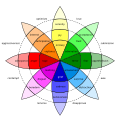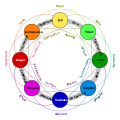Curiosity

Curiosity is an emotion that shows a want or need to know new things. It is shown in behavior such as exploration, investigation, and learning. It is an innate behaviour of humans and many animal species. Curiosity is a major cause and force behind scientific research and other studies.
Curiosity is common to humans at all ages starting from infancy,[1] through adulthood.[2] It is easy to see in many other animal species, such as apes, cats, rodents,[3] fish, reptiles, and insects. Although it is an innate behaviour of many living beings, it is not thought of as an instinct because it is not a fixed action pattern.
A morbid curiosity is an addictive curiosity with death, violence, or something else that may hurt you physically or emotionally.
Curiosity Media
A crowd mills around the site of a car accident in Czechoslovakia in 1980.
References
- ↑ Ofer G, Durban J. (1999). "Curiosity: reflections on its nature and functions". Am J Psychother. 53 (1): 35–51. doi:10.1176/appi.psychotherapy.1999.53.1.35. PMID 10207585.
- ↑ Berlyne DE. (1954). "A theory of human curiosity". Br J Psychol. 45 (3): 180–91. doi:10.1111/j.2044-8295.1954.tb01243.x. PMID 13190171.
- ↑ Berlyne DE. (1955). "The arousal and satiation of perceptual curiosity in the rat". J Comp Physiol Psychol. 48 (4): 238–46. doi:10.1037/h0042968. PMID 13252149.






